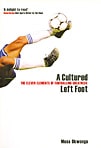 The Eleven Elements of Footballing Greatness
The Eleven Elements of Footballing Greatness
by Musa Okwonga
Duckworth, £15.99
Reviewed by Jonathan O’Brien
From WSC 249 November 2007
Musa Okwonga’s impressive CV includes the fact that he once won a poetry competition, a detail that may well send shudders down the spines of potential purchasers of his new book. In the event, A Cultured Left Foot rarely threatens to end up in Pseud’s Corner, but it still fails to really come together as an analysis of modern footballing excellence.
Okwonga has racked up plenty of air miles and a lot of homework for his essays examining “the 11 key elements that make up footballing greatness”. Some of the attributes seem virtually interchangeable (graft, toughness, endurance), but never mind. In an early chapter, he likens Kaká’s playing style to the dance of a ballerina and cites the Bournonville technique from Eliza Gaynor Minden’s Ballet Handbook to illustrate his point. Later sections quote from a Singaporean doctor’s thesis about the link between genius and madness; a House of Lords judgment on a case involving Manchester police’s Operation Spanner; and The Mourning Bride by the Restoration-era playwright William Congreve.
Those interviewed include Steve McManaman (who brings along Rob Jones, in a poignant juxtaposition of two former team-mates whose careers ended up at opposite ends of the success scale), John Collins, Boudewijn Zenden, Hugh McIlvanney and the former Saudi Arabia striker Majid Abdullah. This last one is something of a wasted opportunity. Abdullah was the best forward in Asian football for years, his standing in that continent somewhere between Gerd Müller and Pelé, but instead of a discussion about his iconic status in the Muslim sporting world, the meeting produces only a few bland quotes about things such as his favourite playing move (he doesn’t have one) and his favourite goal (he doesn’t have one).
Similarly, when Okwonga meets Vic Wakeling, the managing director of Sky Sports (correctly identified as one of the most powerful figures in British football), the interview covers only Wakeling’s memories of George Best and doesn’t touch on anything to do with his day job. This book is full of the right people being interviewed about the wrong things.
While A Cultured Left Foot is far from being a bad book – Okwonga’s a decent writer and his determination to find connections in the unlikeliest of places is admirable – it spreads itself far too thinly. Its subject means that, by definition, it has to have a wide scope, but it hops from anecdote to anecdote, player to player, in rapid-fire fashion without lingering for long enough on any of them.
It’s not so much scattergun as pointillist: either Okwonga felt he didn’t have sufficient room to go into more detail, or he didn’t think he could do some stories full justice in depth. At one point, he touches upon the strange case of Jan Simák, the Czech who flopped abjectly when asked to step into the shoes of Michael Ballack at Bayer Leverkusen, and soon mysteriously disappeared, only resurfacing in a Prague hostelry some weeks later. But the tale is told in just one short paragraph, and you’re left wishing that Okwonga had dwelt on this story – and others – for a little longer.